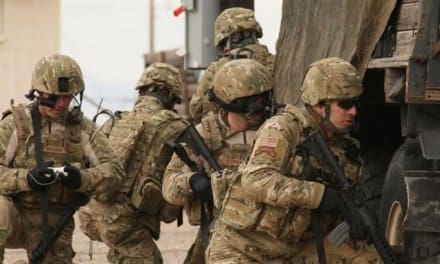The Thunderstorm Technology Demonstration Program is sponsored by the Deputy Assistant Secretary of Defense for Emerging Capability & Prototyping, Rapid Reaction Technology Office (RRTO).
The intent is to accelerate the delivery of innovative capabilities to the warfighter by demonstrating and experimenting with the capability in an operationally relevant environment. The results of this effort will be used to inform decision makers of emerging and available technology solutions that enhance or improve existing capabilities with a focus on small unit operations.
They are soliciting technology candidates from private industry, government research and development (R&D) organizations and academia for inclusion in future capability demonstration and experimentation events focused on the support for small unit operations. Technologies must be at a technology readiness level (TRL) of 4 or greater.
Thunderstorm 18-1 will be the first of a series of FY18 planned events in support of small unit operations, with demonstrations and experiments planned for March 2018 at or near Fort Bragg, NC.
The notional scenario is a small team is deployed for an operation in a potentially hostile region. The team is lightly equipped and required to be highly mobile to support the mission requirements. The operational area may have a variety of physical and electromagnetic environmental constraints. The team is required at all times to operate in all types of terrains (desert, forest, mountain, open, urban, etc.), vegetation (desert, grassland, brush, forest, etc.) and in all environmental conditions.
The program is interested in the following capabilities:
• Wireless tactical headsets for improved tactical communications: resistant to jamming, secure, use within vehicle and with dismounted personnel.
• Power for individual and squads – battery longevity: wearable power generation/harvesting technologies, proximity charging, next generation batteries for Soldier and squads (potential combination of battery & body armor); power management tools (analytics/AI to decide when/how each item is powered for max efficiency).
• Goggle or helmet mounted heads-up display – capability to improve Situational Awareness (SA), Augmented Reality (AR), etc.:
o Display of networked information (sensor display(s), mapping, alerts, etc.), networked to command center, identification of persons of interest;
• Sensor technologies providing enhanced SA – next generation night vision, see through walls, see around corners/over roofs, ID/alert potential threats (predictive analysis), 360° awareness/vision, see through smoke & other obscurants, magnification, stand-off biometrics, etc.
• Sniper training platform – augmented reality and/or virtual reality system for maintaining sniper training.
• Robotic technologies & automation – improved operations thru unmanned systems, automated processes, etc.: support/improve decision making, reduce number of personnel required for mission, remove person from dangerous jobs, e.g. possible CBRNE threats.
o Unmanned Ground Vehicles (UGV) – small, light, man-portable, tactical systems operating autonomously/semi-autonomously; modular payloads to support multiple missions, all terrains.
• Small unit Unmanned Aircraft System (UAS) – ability to operate in buildings or tight spaces
• Covert UAS – stealth to perform surveillance and reconnaissance missions without attracting unwanted attention due to its visual and/or acoustic properties; small UASs (Group 1 (0-20 lb.) and Group 2 (21-55 lb.)) that can be launched and recovered without the use of a runway.
• Personnel signature management – textiles/material to manage signature of radar, electronic, thermal, infrared, visual, electro-optical, and acoustic detection technologies. Alter or camouflage aspects of the operator or their equipment to make them undetectable and/or unrecognizable.
• Soldier down/medical alert – person in need of medical care, reports medical condition/status, contains pertinent medical records.
o Ability to scan personnel (with associated wearable technology or leads as required).
o Ability to determine Soldier workload, hydration, heartrate, blood pressure, temperature, and other vital health indicators to support Soldier efficiency and “The Golden Hour” from injury to medical support.
• Multispectral beacon – non-signals ability to quickly identify all personnel and their positions in all weather and climate conditions; providing positive identification to overhead close air support.
• Security for commercial off-the-shelf (COTS) apps – ability to utilize standard apps with an encryption level to support communications with Partner Nation Force (PNF).
• Cellphones teamed with HF/VHF transceivers – ability to send text and other data (encrypted) from a cellphone over an HF / VHF transceiver.
• Tactical hotspot or denied area internet – providing LTE and Wi-Fi and an information gateway in a denied environment.
• PNF communications and sensor control systems using indigenous commercial systems – exfiltration of secure data (AES encryption) from PNF via commercial system; data pulled, viewed and heard in real-time.
• Suppressed weapon system – accurate fires providing quieter, less flash, reduced recoil, lighter, stronger system.
• Lensless cameras – lightweight systems that do not require mechanical movement to capture images.
• LED LIDAR – lightweight systems that can provide near range measurements.
All capabilities should emphasize individual mobility and automated operations with a goal of limiting/reducing size, weight, power, etc. and reducing or eliminating operator workload requirements.
Although the date on FBO has passed to accept applications, the KO will take additional applications until 1700EST Friday, 5 Jan 18.
For instructions on how to apply, visit www.fbo.gov.



Pretty soon, being a grunt will be like being a fighter pilot. Low ASVAB need not apply…
Wow, that photo is about 11 years old
Is it? I can barely see those guys…
All these gadgets and gizmos but BRM training is woefully inadequate in Big Army still.
Sounds like they’re interested in increasing their new IP library so they can have some projects to pilfer and find a way around paying royalties.